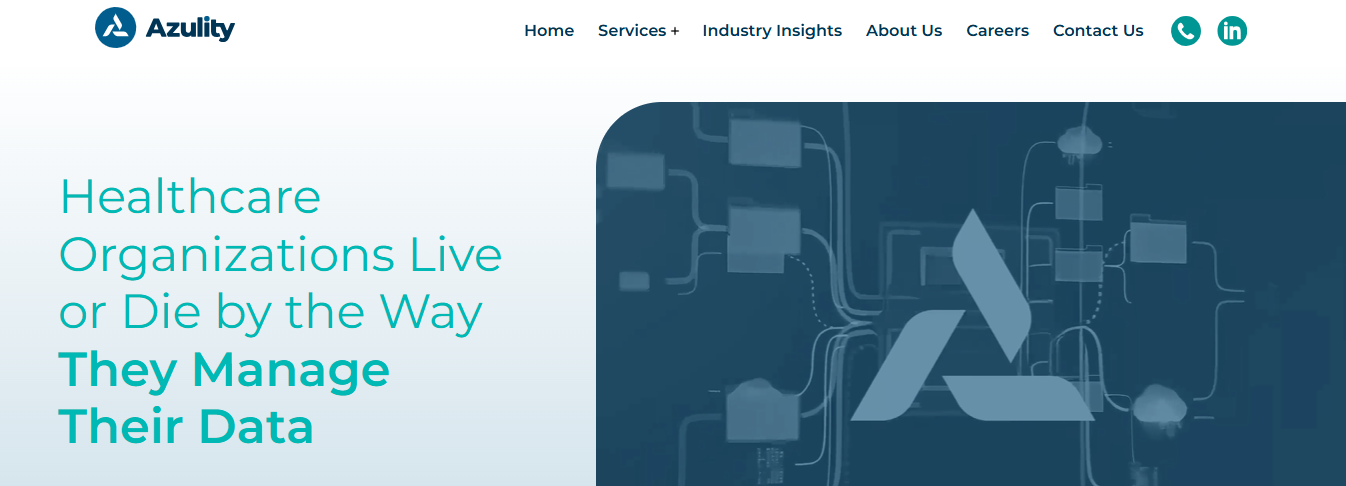Patients seeking appropriate care expect skilled professionals to treat them and ease their burdens. However, rising staffing issues in healthcare often hinder well-meaning practitioners’ efforts to resolve care gaps. Recruitment challenges prevent healthcare organizations from hiring qualified professionals, so patients take longer to receive treatment, and staff become overwhelmed and burnt out.
This guide explores recruitment challenges in the healthcare industry and offers valuable insights to help organizations achieve their goals, such as allowing healthcare services with credentialing.
Azulity’s provider credentialing services can help relieve the burdens of staffing issues in healthcare by streamlining the process of verifying clinicians’ qualifications. With our solution, your organization can quickly onboard qualified professionals to ease the burdens on your existing staff and improve patient care.
Importance of Recruiting the Right People in Healthcare Industry


Impact on Patient Care Quality: The Link Between Recruitment and Patient Care
Patient care lies at the heart of healthcare. Naturally, the quality of care provided is directly linked to the caliber of professionals delivering it. By implementing robust recruitment strategies, healthcare organizations can attract highly skilled professionals, ensure a diverse workforce that reflects the patient population, and bring fresh perspectives and innovative approaches to care. When healthcare facilities prioritize recruitment, they invest in better patient outcomes and satisfaction.
Attracting Top Talent: Building a Reputation for Excellence
A healthcare organization’s reputation is closely tied to its ability to attract and retain top talent. Recruitment strategies prioritizing hiring skilled and experienced professionals contribute to a positive reputation within the industry. Word-of-mouth recommendations, positive reviews, and professional accolades all play a role in attracting high-caliber candidates. A strong reputation can also make it easier to recruit for hard-to-fill positions and attract candidates from competitive markets.
Addressing Staff Shortages & Burnout: Recruitment as a Solution
The healthcare industry is notorious for staff shortages and high burnout rates, particularly in specialized fields such as nursing, radiology, and surgical care. Effective recruitment strategies can mitigate these issues by ensuring adequate staffing levels, reducing workload on existing staff, and introducing new team members with fresh energy and ideas.
By continuously bringing in new talent, healthcare organizations can create more balanced and sustainable work environments, increase job satisfaction, and reduce turnover. This involves anticipating future staffing needs and seeking qualified candidates before vacancies become critical. Building a pipeline of potential hires and maintaining relationships with educational institutions can help healthcare organizations avoid staffing challenges.
Flexible Staffing Solutions: Adapting to Fluctuating Demands
In addition to traditional recruitment methods, healthcare organizations can benefit from flexible staffing solutions such as temporary staffing, part-time roles, and telehealth positions.
Healthcare recruitment strategies incorporating these options can help organizations adapt to fluctuating patient volumes and changing healthcare demands. This flexibility ensures patient care isn’t compromised during peak times or unexpected staff shortages.
Keeping Pace with Technological Advancements: Recruiting for the Future
Healthcare technology is advancing at breakneck speed. From AI-assisted diagnostics to telemedicine, the industry requires professionals who aren’t only medically competent and technologically savvy. Recruitment strategies should include assessing candidates’ proficiency with technology and their ability to adapt to new advancements.
Furthermore, ongoing training and development programs can help existing staff stay current with the latest technological trends, ensuring the organization remains at the forefront of healthcare innovation.
Embracing Digital Recruitment Tools: Streamlining the Hiring Process
As the healthcare industry continually evolves with technological advancements, recruitment strategies must keep pace. Digital recruitment tools, such as applicant tracking systems (ATS), social media platforms, and online job boards, have become integral to modern recruitment processes. These tools streamline the hiring process, making it more efficient and effective. By embracing technology, healthcare organizations can reach a wider pool of candidates and make data-driven hiring decisions.
Cost-Effectiveness & Resource Optimization: The Long-Term Benefits of Effective Recruitment
While investing in recruitment might seem costly up front, it’s a strategy that pays dividends in the long run. Effective recruitment can reduce turnover costs, lower training expenses for new hires, and improve operational efficiency. By bringing in the right people, healthcare organizations can optimize resources and reduce the financial burden of constant hiring and training cycles.
Building a Positive Work Culture: Hiring for Team Fit
Effective recruitment strategies build a positive work culture, essential for employee satisfaction and patient care. By hiring individuals who align with the organization’s values and mission, healthcare facilities can create a cohesive and supportive work environment. A positive work culture enhances employee morale, leading to better collaboration, improved patient care, and a lower turnover rate.
Adapting to Changing Healthcare Models: Recruiting for Value-Based Care
The healthcare industry is shifting toward value-based models, emphasizing preventive care and patient outcomes. This transition requires a workforce that’s adaptable, patient-centered, and focused on holistic health. Effective recruitment strategies help healthcare organizations identify and attract professionals who can thrive in these new care delivery models.
Meeting Regulatory & Compliance Requirements: Recruitment and Legal Standards
Healthcare is a highly regulated with strict staffing ratios, qualifications, and continuing education requirements. Strategic recruitment ensures healthcare organizations can meet and exceed regulatory standards, maintain proper staffing levels across all departments, and ensure all staff members have the necessary credentials and qualifications. By prioritizing compliance in the recruitment process, healthcare facilities can avoid legal issues and maintain their reputation for quality and safety.
Fostering Innovation & Research: Recruitment for the Future
Many healthcare organizations aren’t just care providers but also research and innovation centers. Effective recruitment strategies can attract researchers and academics, professionals passionate about innovation, and individuals with diverse backgrounds and perspectives. By bringing together diverse groups of talented professionals, healthcare organizations can foster environments of continuous learning and advancement, contributing to the overall progress of medical science.
Addressing Specialized Skills Gaps: Targeted Recruitment Efforts
Healthcare is a field of specialization, and recruitment strategies are crucial in addressing skills gaps in niche areas. Whether it’s finding neurosurgeons for an expanding brain center or genetic counselors for a new personalized medicine program, targeted recruitment efforts ensure healthcare organizations can meet specific needs and expand their service offerings.
Preparing for Future Challenges: Recruitment as a Workforce Strategy
The healthcare landscape is constantly evolving, with new challenges emerging regularly. From global pandemics to the rise of chronic diseases, healthcare organizations need to be prepared. Strategic recruitment allows these organizations to build a workforce with diverse skill sets, create adaptable teams that can respond to crises, and develop leadership pipelines for future organizational growth. By thinking ahead in their recruitment efforts, healthcare organizations can position themselves to tackle future challenges head-on.
9 Serious Recruitment Challenges in Healthcare Industry


1. Candidate Attraction: The First Hurdle in Healthcare Recruiting
Candidate attraction is one of the biggest healthcare recruitment challenges. The health and care sector has suffered from staff shortages for many years. Recent years have made life even harder. The Health Foundation says that more health and care staff are needed to meet demand, improve services, and recover from the pandemic by 2030.
Skills for Care reports that care worker vacancy rates in 2021/22 were twice as high as the national average, at 11%. The CIPD’s Labour Market Outlook Autumn 2022 finds that 55% of recruiting employers in the UK healthcare sector report hard-to-fill vacancies—the highest proportion of any industry.
Private health and social care providers will likely face further challenges in retention and attraction due to the 5.5% pay increases announced recently by the NHS. Many are unable to find the financial resources to match them. And there’s no end in sight. The aging population is getting older, and demand is increasing.
The healthcare workforce is getting older, too, and is coming ever closer to retirement. Plus, long COVID is stubbornly sticking around, adding long-term pressure on healthcare professionals and hurting their health more than anyone’s. Faced with massive talent shortages and colossal competition, healthcare recruiters must focus on developing proactive candidate attraction strategies. If not, worsening care quality and patient outcomes are on the horizon.
2. High Turnover and Retention Issues: The Common Cause of Healthcare Staffing Shortages
Burnout, job dissatisfaction, and poor work-life balance lead to high turnover rates. Healthcare workers face heavy workloads and long hours, which deter candidates from pursuing healthcare roles. Inadequate compensation and benefits fail to reflect the demanding nature of the job.
As a result, many healthcare positions remain unfilled for extended periods. On average, healthcare businesses take 48.3 days to fill a vacancy, which is more than 20 days longer than other industries. Lengthy decision-making, complex employment screenings, and extensive training requirements all contribute to this delay.
3. Rising Costs: The Financial Burden of Healthcare Recruitment Challenges
Skills shortages and turnover are expensive problems. One 2022 study says nurse turnover alone costs the average hospital millions yearly. And too-long time-to-hire loses great people, forcing you back to job boards or towards stop-gap agencies. And that’s before you consider soaring inflation, piling pressure onto healthcare profit margins.
McKinsey calls inflation a “gathering storm” that could “put nearly half of profit pools at risk”. In 2023, healthcare recruiters must focus on building a more efficient recruitment process to make every moment (and penny) count. The age-old ‘do more with less’ dilemma has never been so important.
4. The Skills Gap and Technological Advancements: Keeping Up With Healthcare Recruitment Challenges
The rapid evolution of medical technology adds another layer to recruitment challenges. Healthcare roles often require: Special skills and qualifications that are difficult to find, particularly for niche roles like nurse practitioners and rheumatologists.
Continuous upskilling to adapt to emerging technologies and systems. Unfortunately, many healthcare HR teams have yet to leverage advanced talent acquisition tools fully. This gap limits their ability to efficiently identify, attract, and retain highly skilled candidates.
5. Hiring Manager Experience: Why Healthcare Recruitment Is Slow
Healthcare recruiters are pressured to hire faster, but hiring managers can be a significant bottleneck. According to Jobvite, 56% of recruiters say their biggest bottleneck is hiring managers moving candidates through hiring stages too slowly. 43% of recruiters say their biggest bottleneck is hiring managers reviewing CVs too slowly. 25% of recruiters say they’ve witnessed or experienced a candidate interview that took four or more hours.
That’s an even bigger deal as frontline healthcare workers battle increasing pressure, workload, burnout, and fatigue. It’s the perfect storm: a fast, effective recruitment process is more important than ever, but hiring managers have almost zero bandwidth. In 2023, healthcare recruitment teams must improve collaboration to speed up recruitment and enhance the candidate experience.
6. Diversity and Inclusion Challenges: The Need for a More Culturally Competent Workforce
Building a diverse and culturally competent workforce remains an ongoing issue in healthcare. Organizations face challenges such as:
- Underrepresentation of specific demographics in key healthcare roles
- Addressing discrimination and inequalities in pay and career progression
- Diverse teams are critical to serving a wide range of patient populations, yet progress in this area remains slow.
7. Black Holes: Poor Data Visibility in Healthcare Recruitment
Poor data visibility is a big issue in almost every industry. But it’s awful for decentralized healthcare organizations, with hundreds of managers and complex recruitment processes. Many healthcare recruiters say they can’t easily track even the basic stuff. Like:
- How many roles are open, where?
- How long have those roles been open?
- Why have those roles stayed open?
- How many candidates have applied?
- Which sources do candidates come from?
- How many candidates are we interviewing?
- Which candidates are we onboarding?
- Have candidates been sent the right contracts?
- Have we verified candidates’ compliance documentation?
- Who’s accountable for what, when?
- Which hiring managers are doing what, when?
- How are recruiters or teams performing?
- Where do hiring managers need extra support?
The problem is that poor visibility translates into poor control. The candidate experience is usually shoddy and inconsistent, plus your recruitment team is practically working nights just to handle basic admin. And your exposure to risk goes through the roof. Plus, if you can’t easily get the answers to questions like these, you can’t see where you could improve.
You recognise the symptoms – rising recruitment costs, threatened care ratios, even enforcement action – but black holes mean you can’t diagnose or cure the problem. Healthcare recruiters need to equip data to their advantage, to move the needle on their most important outcomes.
8. Regulatory and Compliance Complexities: The Rules of Healthcare Recruitment
Healthcare recruiters must navigate an intricate landscape of policies, regulations, and certifications. Immigration policies, which impact international talent recruitment, add another hurdle for organizations attempting to address staffing shortages.
9. ED&I Progress: The Need for Healthcare Recruiters to Do More on Diversity
Many healthcare organizations are doing a fantastic job of improving workforce diversity. In 2021, for example, the NHS workforce was the most diverse in its history. Despite positive progress, much work is still needed to achieve equal representation. Recent research from the CIPD showed that only 47% of UK employers have an ED&I strategy, for example. Healthcare recruiters can’t rest on their laurels.
And making progress is a significant opportunity, when so many other businesses aren’t. ED&I is a substantial priority for job seekers: your diversity credits are essential to your employer brand. For example, Glassdoor finds that 67% of job seekers look at workforce diversity when evaluating companies and job offers. A fair and inclusive recruitment process also opens talent pools you might otherwise be excluding. Healthcare recruiters must make 2023 the year of real progress on ED&I.
Related Reading
- Resource Allocation in Healthcare
- Healthcare Workforce Shortage Solutions
- How to Recruit Healthcare Professionals
How to Overcome Healthcare Challenges


1. Use Azulity to Streamline Healthcare Recruitment
Azulity specializes in healthcare master data management and provider credentialing services. Their team has extensive experience implementing healthcare data solutions and credentialing across the US. Azulity’s comprehensive platform consistently synchronizes patient, provider, location, and claims data across all systems and departments.
Key features include healthcare MDM, provider MDM, reference data management, credentialing, and provider enrollment. They serve healthcare technology leaders—from CIOs and CDOs to VPs of data platforms and credentialing—helping them eliminate the costly problems of fragmented data systems. Book a call to learn more about Azulity’s healthcare master data management services today!
2. Tap into Job Boards to Find Qualified Healthcare Candidates
Job boards can help healthcare organizations recruit qualified candidates. They allow management staff to reach various candidates by advertising open positions and monitoring the number of applicants.
Healthcare professionals can see how many people click on their advertisements, which gives them an idea about their brand awareness in the marketplace. If they have questions about applicants or potential employees, job boards allow staff to contact them directly through email or other means.
3. Highlight Compensation and Benefits to Attract Healthcare Talent
Evaluate company benefits and compensation packages to ensure you offer candidates good incentives. Update outdated company policies and draw attention to new benefits likely to resonate with your audience. The company’s compensation and benefits may be the deciding factor for candidates choosing between the organization you work for and a competitor.
Some common benefits to highlight include flexible work environments, telecommuting policies, career growth and training opportunities, debt relief, financial bonuses, and mentoring sessions. Capitalize on various types of benefits to capture a wider talent pool.
4. Offer Internships to Students to Build Your Pipeline
Internships introduce students to what it’s like working on the job. They also allow them to see if they like the work environment and how healthcare organizations operate. Internships can also help recruitment officers identify individuals talented in areas that may not be immediately apparent when interviewing them for full-time roles.
For example, if they’re looking for someone with specific medical knowledge or skills, but don’t have the budget to hire someone with those qualifications right away, they can offer students an internship where they receive training on those topics. At the same time, they work on other projects that do not require that expertise. They can offer students a full-time position if they do well during their internship.
5. Seek Talent From Related Medical and Public Healthcare Fields
When seeking qualified candidates, look at other medical or public healthcare branches related to your field. This approach widens your talent pool and attracts candidates who may not have applied for your job opening.
For instance, nurses who previously avoided progressing in their career because of the challenges associated with the healthcare sector may feel more confident applying if your recruitment strategy outlines how your company intends to relieve these challenges and foster a more positive work environment. Consider targeting travel nurses or temporary nurses who may want more permanent work.
6. Develop a Referral Program for Employees
Developing a referral program is an effective healthcare recruitment strategy because it helps organizations keep their employees happy while attracting new hires. Employees who feel treated well are more likely to refer others to the organization.
This means that instead of advertising, organizations can use this money to provide bonuses and other rewards to employees. This approach also helps attract new hires by helping them settle into work faster, as they have an ally in their new workplace.
7. Embrace Diversity and Inclusion in Your Recruitment Strategy
Recruiting healthcare professionals from diverse backgrounds is essential for increasing creativity and widening your talent pipeline. A diverse workforce allows you to draw from varied perspectives and use insider information to target more diverse patient markets.
Promoting diversity in the workplace also fosters a more positive work environment that focuses on collaboration between people. This commitment to inclusivity boosts staff retention and referral hires, making you spend less on recruitment strategies in the future.
8. Create a Career Page on the Organization’s Website
Creating a career page on an organization’s website attracts and retains top talent by providing employees with the information necessary for applicants to make informed career decisions. It also allows them to see what it’s like to work at the company, which can help you attract more applicants. This is because they can look at photos of the premises to gauge an understanding of practices. Blog posts and newsletters posted regularly can also provide additional insight.
9. Assess Soft Skills Alongside Specialized Knowledge
Alongside specialized knowledge and skills, healthcare professionals also require a range of soft skills to ensure they approach patients correctly. Some essential soft skills to look for during the recruitment process include:
- Interpersonal skills
- Communication skills
- Teamwork skills
- Time management skills
- Adaptive skills
- Patience
Focusing on these skills throughout the recruitment process guarantees that you hire candidates who take a people-centered approach to their work and place a high value on helping patients. Be sure to prepare interview questions that allow candidates to demonstrate these traits. Before the interview stage, you can use scenario-based questions, evidence-based questions, or even psychometric assessment tools.
10. Conduct Interviews Using Technology
There are several reasons why virtual interviewing tools are a good healthcare recruitment strategy. They allow candidates to experience the new position before accepting any offer, which can help reduce turnover. Also, they save the hiring company time and money, as less travel is required.
Video conferencing allows interviewers to select a time that works best for them, rather than working around travel schedules at different locations. This technology also allows hiring companies to see how applicants present themselves, which helps them to determine if a candidate can fit into the corporate culture.
11. Create a Behavioral Health Assessment Routine
A behavioral health assessment allows you to determine candidates’ future performance by using past behaviors or experiences as an indicator. The evaluation involves a series of questions and interviews that help you identify how candidates responded to specific situations in the past.
It provides information on a candidate’s behavioral competencies, traits, and temperament while working in a healthcare setting. Drawing conclusions based on real-life experiences is a good way to determine whether a candidate’s actions or thought process align with the company culture or vision.
12. Build Relationships With International Healthcare Professionals
Building relationships with healthcare professionals from other countries is an effective healthcare recruitment strategy because it helps an organization find new talent. Recruitment officers looking for more qualified doctors, nurses, and other medical professionals should go where the best ones are.
Another reason is that it can help a hospital or clinic’s reputation internationally, leading to a better applicant pool. As these employees settle in, they can suggest how to improve a medical practice by recommending lesser-known practices from different cultures and traditions.
13. Refine Your Hiring Process Regularly
It’s essential to update your outreach methods frequently to reach more candidates. Individuals are also less likely to apply for a position if they feel the practice is outdated. Leverage a hiring process that allows you to use modern outreach methods, such as social media and built-in website applications.
Be sure to improve other areas of the recruitment process, too. This includes updating the questions you ask in the interview, the compensation and benefits you offer, and how you represent your brand culture throughout the various recruitment stages.
14. Start a Blog About Hiring and Interviewing Tips for Healthcare Professionals
Starting a blog about hiring and interviewing tips for healthcare professionals is an effective healthcare recruitment strategy because it allows recruitment officers to connect with potential candidates in a way that’s more personal than other methods.
Blogs are an excellent way for professionals to share their expertise with others and to explain the reasons behind their hiring process. When looking at an organization’s job listing, it can be challenging to gauge the specifics of the role and what it’s like to work there. By reading a blog instead, applicants can better understand what working there involves explicitly.
15. Create a Multi-Platform Recruitment Campaign
Creating a multi-platform recruitment campaign ensures you reach a wider range of qualified candidates than if you were to stick to posting on job boards or social media. This approach increases the visibility of your job offerings and makes it more likely that the right candidate sees them. Some platforms to consider posting your recruitment opportunities include social media, the company careers page, job boards, the company newsletter, emails, and the company website.
Mistakes to Avoid While Recruiting Healthcare Professionals


1. Avoiding the Mistake of Forcing a Fit in Your Healthcare Recruitment Efforts
It can be easy to get tunnel vision after a candidate makes it to the interview stage of your healthcare organization’s hiring process. A healthcare candidate may have the proper credentials to start the job, but that doesn’t mean they will thrive in your workplace. For instance, they may lack the soft skills to communicate effectively with patients or your existing team.
Alternatively, they might be averse to change or have different values that don’t align with your organization’s culture. If you overlook these potentially problematic areas just because the candidate has the skills to perform the tasks listed in the job description, you could be setting your team up for failure. It’s better to take your time and find the right fit rather than forcing candidates into a role they aren’t suited for.
2. The Importance of Writing Compelling Job Descriptions
When you’re focused on growing an all-star team, writing custom job descriptions wastes precious time that could be spent building relationships with great candidates. Yet, the quality of your job listing directly affects the quality of candidates you will attract. Posting the same canned job description every time you need to hire makes it look like you need to place more value on how your employer brand is perceived.
Write more compelling job descriptions to engage more top-tier candidates. Use a tone and language consistent with your company culture. Distinguish between the qualifications that are must-haves and those that are preferred. Use active rather than passive voice. Use outcome-based descriptions to convey what the right candidate looks like. For example, for a pharmacy technician, instead of just listing ‘communicates medication information,’ you might say ‘helps patients achieve better health by providing a more thorough understanding of their medications.’
Highlight the benefits of joining your organization and the opportunities, like advancement and other benefits, the role will present. While you do not need to recreate every single job description from scratch, take the time to update your pre-written template with a few customizations specific to the role. This demonstrates your investment in making a positive first impression and strengthens your employer brand.
3. The Importance of Having a Structured Hiring Process
Experiencing your hiring process gives candidates a glimpse of how your organization runs. If that process is disjointed, candidates may conclude that your workplace is disorganized or dysfunctional. An effective healthcare hiring process needs to have both structure and strategy. Each phase in the process should be there for a reason and should have a clearly defined set of steps and a timeline to complete it.
For example, what messages are sent after a candidate takes an action like submitting an application or completing a skills assessment? How much time passes between completing that action and starting the next step? If you can’t easily answer such questions, creating a documented phase-by-phase breakdown of your hiring process would serve you well. This documentation ensures everyone involved in hiring is on the same page and helps the process move smoothly and efficiently. A strategic hiring process creates a positive candidate experience, making you more likely to get an accepted offer.
4. Avoid Being Overly Pushy During the Recruitment Process
Recruiters often get a bad rap, and one of the biggest complaints among candidates is that they are too pushy. When you are excited about a candidate, your first instinct might be to pursue them aggressively. You mean well, and your intent is in the right place, but this can be a significant turnoff to top candidates, some of whom are likely being pursued by several companies all at once.
When you come on too strong, you risk giving the impression that the company is desperate to hire, or worse, that you are desperate for the commission that comes with a successful placement. Avoid alienating candidates by giving the relationship space to grow organically and giving the candidate time to respond on their terms. Avoid calling them at work. For obvious reasons, most candidates want to be discreet about the fact that they are looking for a new role. Contacting them when they are on the clock at their current job is the fastest way to spook them.
5. The Importance of Conducting Interviews Well
It’s hard to overstate the importance of your interviews. For many candidates, this will be the only time they have an extended conversation with a representative of your company. If the interview is uncomfortable, off-putting, or even off-topic, there’s a good chance a candidate will think twice before deciding to proceed with being considered.
Some of the most common interviewer offenses include asking vague questions, which can signal that they didn’t prepare ahead of time, lacking a firm understanding of the job, and being generally awkward (being too serious or not serious enough, for example).
Position interviewers to succeed by pre-planning a list of questions tailored to each role, allowing enough time to review candidates before the interview, and examining the interviewer’s hiring success rates to identify whether anyone might benefit from additional training or practice.
6. The Importance of Communication throughout the Hiring Process
Another top candidate complaint about recruiters? They go radio silent. The other side of the coin from being too aggressive is not being communicative enough. The best healthcare talent gets snatched up quickly. The last thing you want is to lose one of your top choices because they took another offer while waiting to hear from you.
Even if your hiring funnel moves slowly, keep candidates in the loop about where things stand. Check in regularly to update them on the process and let them know that they are still in the running. Remember, this does not always have to be done via phone call; busy healthcare candidates are appreciative when you use more convenient channels like email and text messaging. If a candidate has been eliminated from the running, by all means, give them the courtesy of being informed.
7. Avoid Slow Hiring Processes
The healthcare field is known for bureaucracy and red tape. As a result, it’s easy to become complacent about lengthy hiring timelines and dismiss them as “just the way they are.” This is a critical error. You’re not just competing with other employers when hiring for healthcare roles. You’re also up against widespread burnout and a critical shortage of skilled workers.
There’s no time to waste: your hiring process lags every additional day, which compounds how difficult it is to hire. So how long is too long? While the overall length of the hiring timeline is essential, and speeding it up is always a good thing, focus instead on the length of time that passes between each step in the process (this is another reason why it’s beneficial to have a cohesive hiring strategy).
If two weeks pass after an interview without a candidate hearing any news, for example, there’s a significant risk they’ll lose interest or move on to another position. By shortening your time to hire and the window between each hiring phase, you’ll keep candidates engaged and emphasize your strong interest.
Azulity: A Solution to Healthcare Staffing Issues


Azulity specializes in healthcare master data management and provider credentialing services, bringing proven expertise in implementing healthcare data solutions and credentialing across the US. Our comprehensive platform ensures consistent patient, provider, location, and claims data synchronization across all systems and departments.
Key features include: healthcare MDM, provider MDM, reference data management, credentialing, and provider enrollment. We serve healthcare technology leaders – from CIOs and CDOs to VPs of data platforms and credentialing – helping them eliminate the costly problems of fragmented data systems. Book a call to learn more about our healthcare master data management services today!
Related Reading
Book a Call to Learn More About Our Provider Credentialing Services
In today’s healthcare environment, the shortage of qualified staff and the high turnover rates of healthcare workers make recruiting and retaining talent challenging. Azulity can help healthcare organizations tackle these daunting staffing issues by improving existing processes to ensure better data accuracy and completeness.
For example, Azulity’s credentialing solutions can help automate and streamline the time-consuming processes of verifying and managing healthcare professionals’ credentials. Faster, more efficient credentialing and enrollment mean that organizations can quickly bring new talent up to speed and get them working to alleviate staffing shortages.
